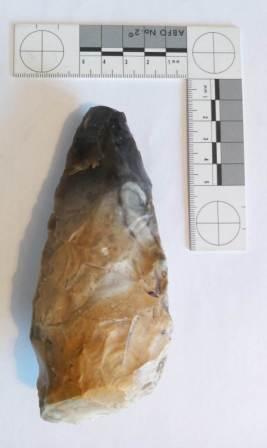We previously mentioned a flint discovered at Shorne, given to us by a member of the public. A closer look has revealed that based on its shape and form, it can be argued to be Neolithic in origin and not Mesolithic as once thought. For a detailed discussion on the flint, provided by Nick Murphy of Flint Finds of History, read on…

The style of knapping has produced a tool that goes from a pointed base to an increasingly broad width tool, which is not consistent with a UK Mesolithic adze. The latter are consistently tubular and a regular width from base to cutting head. Many adze have an offset base-plate which seems to be an aid to seating them inside a socket and perhaps associated with impact cushioning. That said I have seen Mesolithic adze with narrowed pointed bases; but they are far less common. One personal find from the Mesolithic site of Broomhill.
Adze usually feature a broad square to rectangular cross section, where as this is more elliptical, which is a common design with Neolithic core tools. And whilst the Mesolithic pointed forms may match at the base profile they are fundamentally different down the body of the tool, with irregularity in shape in both curvature and elongation…..slightly banana 🙂
Mesolithic axes are extremely rare and my own finds (of which I am confident) include one broad tip sharpening flake (from Dorset) and one core tool (from Broomhill, Hampshire). They are roughly made and could not be confused with the one you feature. Other broad woodworking tools from the Mesolithic include bell-shaped axes and large flake tools; but again they are all roughly made objects. Indeed it seems that only Mesolithic adze seem to have attracted any level of craftsmanship. I have given some time to research of Mesolithic adze and axes and there is one very good excavation from which four tip sharpening flakes were found, but no complete examples. So the complete form is unknown. The other headline digs, such as Star Carr have found none at all. Indeed Star Carr has thus far only recovered 4 adze !
I would discount this being a Neolithic mining tool, as even my best axe-shaped variants are not this well made. So it would exceed any I have seen thus far, from either personal finds or those I have seen on this Group or in publications.
The knapping style it is not as ‘clean’ as most Neolithic core tools. This could simply reflect the skill, time constraint or reduction in care of the maker. It certainly is not the work of a Neolithic craftsman who was doing this as a day-job. If you look at knapped-only examples from the stashes next to Neolithic mines they are uniform and highly consistent in outcome.
My impression is that your piece is a Neolithic axe made by a non-craftsman; which could so easily be misinterpreted as Mesolithic.
For anyone specifically interested in Flint history and ongoing research visit the Flint Finds of History FaceBook page, where you can request to become a member.
